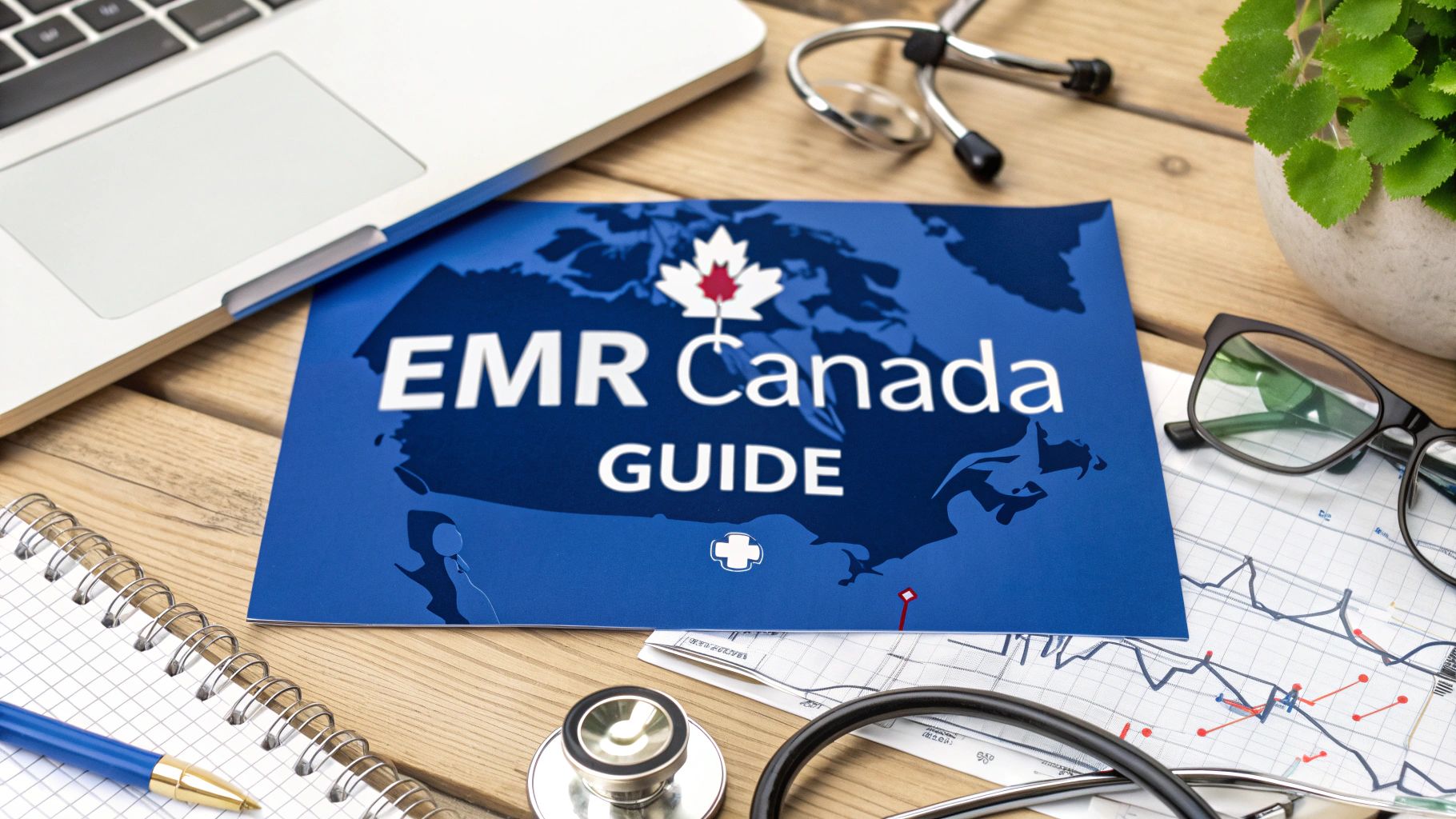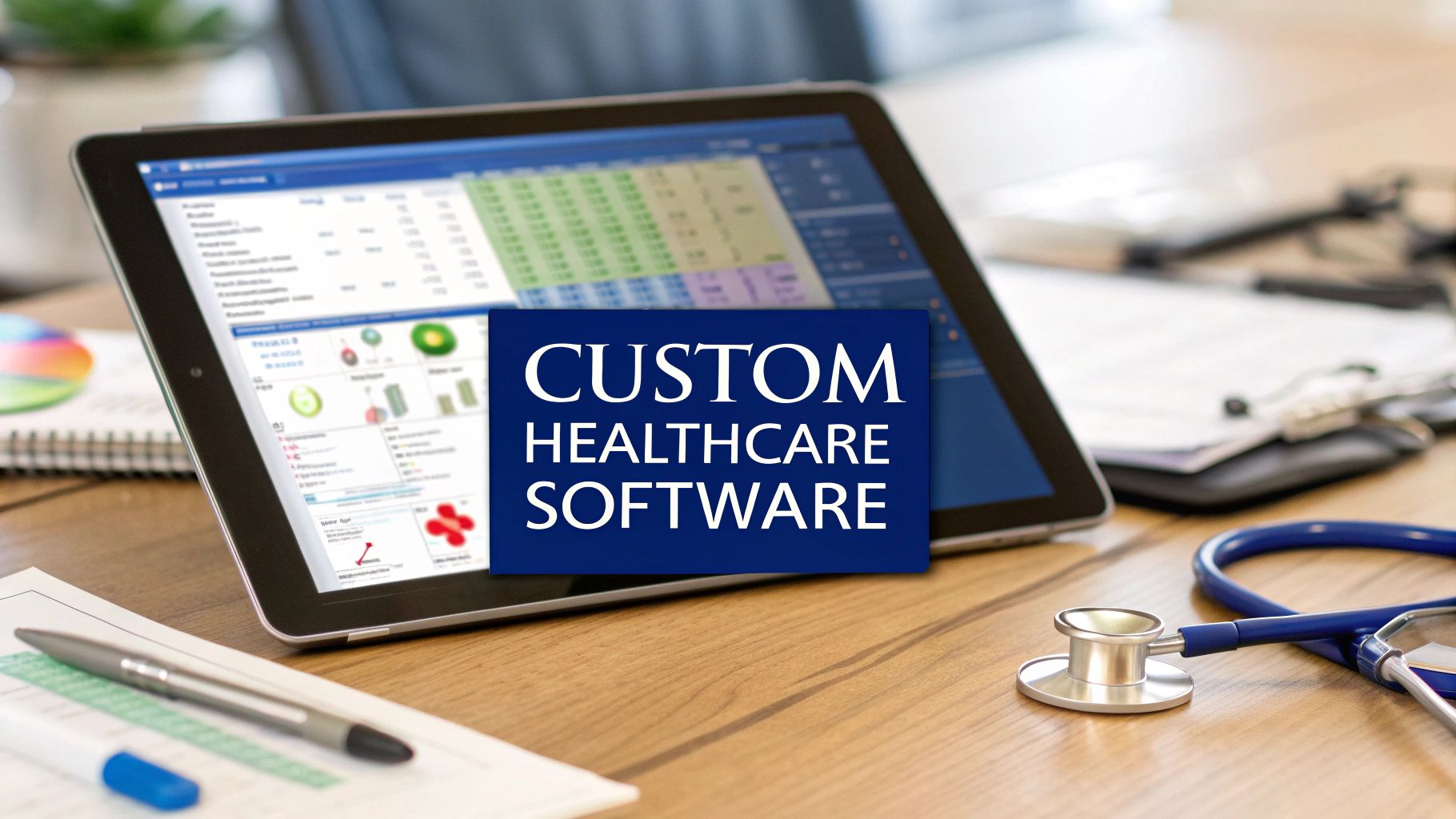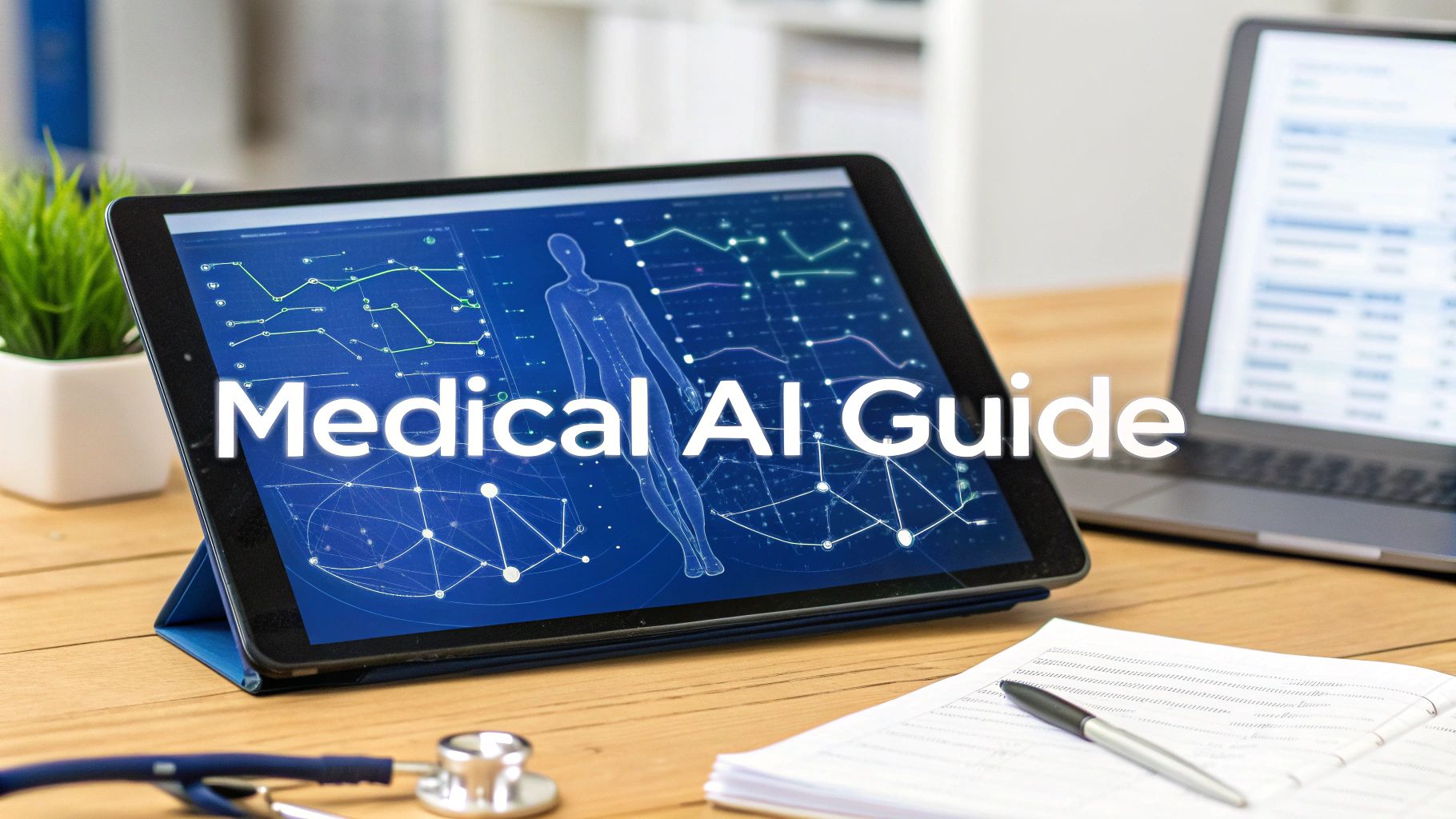Are you still managing your practice with stacks of paper files or a clunky server tucked away in a back office? There's a better way. Cloud-based healthcare software in Canada provides a secure, modern solution, giving clinics instant access to patient data, telehealth tools, and simplified billing – no matter where they are. Think of it as the digital foundation for a more efficient practice and a higher standard of patient care.
Why Canadian Healthcare Is Moving to the Cloud
For a long time, Canadian medical practices ran on on-premise systems. That server humming in a closet held all your patient data, but it also came with a hefty price tag for maintenance, zero flexibility for remote work, and a constant headache of manual updates. The healthcare landscape has changed, and the old way of doing things just can't keep up with the demand for connected, efficient, and patient-centred care.
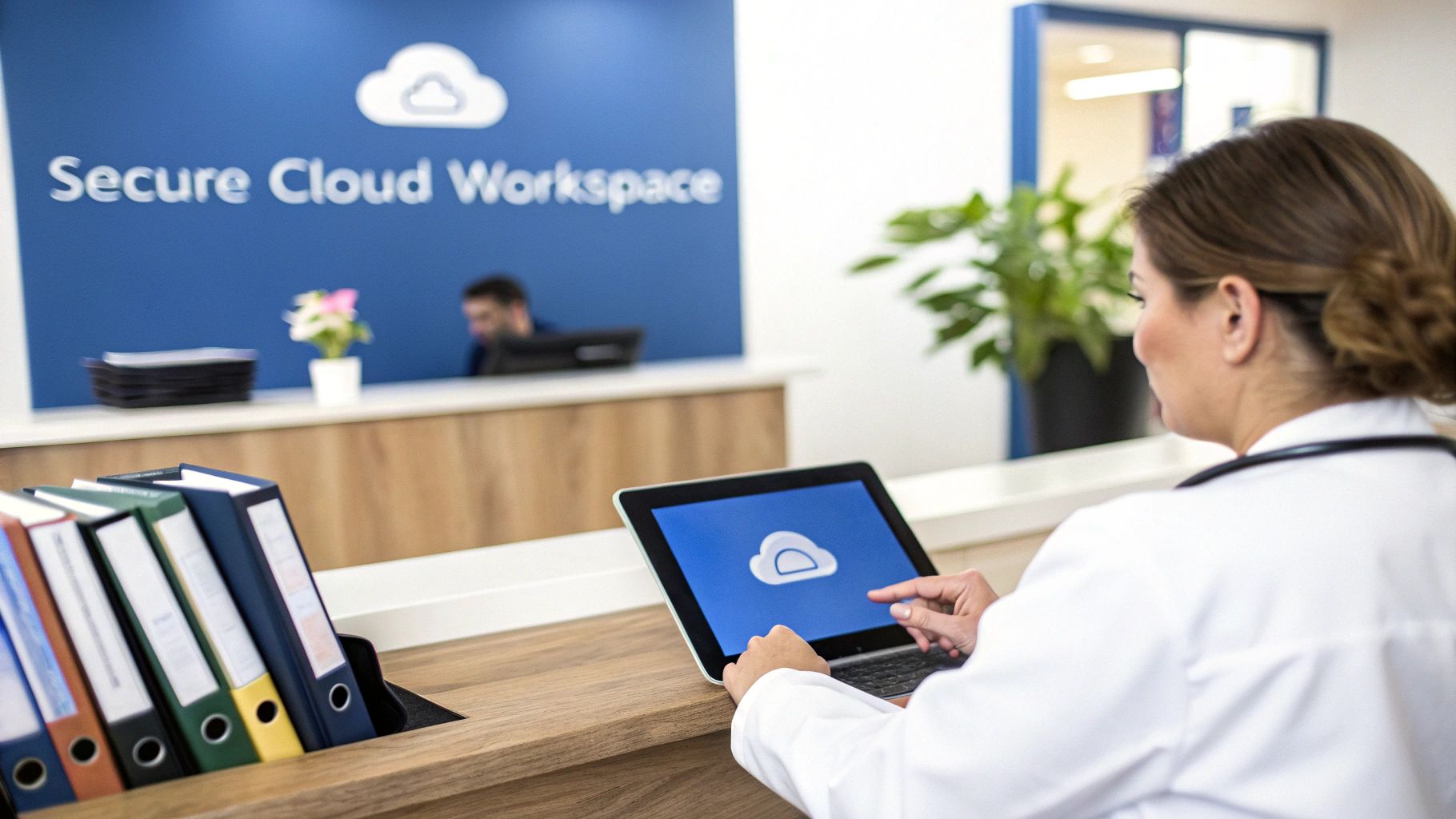
This move to the cloud isn't just a tech upgrade; it's about fundamentally rethinking how healthcare is delivered to meet modern expectations. It's a critical piece of the broader digital health transformation happening across Canada, as clinics look for smarter ways to run their operations and serve their communities.
To put it simply, here’s a quick overview of what this shift entails for a Canadian practice.
Cloud Healthcare Software at a Glance
| Aspect | Key Benefit or Consideration |
|---|---|
| Data Access | Secure, on-demand access to patient records from any location with an internet connection. |
| Core Technology | Software is hosted by a third-party provider, eliminating the need for on-site servers. |
| Security | Providers must adhere to strict Canadian data privacy laws like PIPEDA and provincial PHIPAs. |
| Scalability | Easily add or remove users and features as your practice grows without major hardware changes. |
| Cost Model | Typically, a subscription-based (SaaS) model, which converts capital expenses into predictable operating costs. |
| Interoperability | A key goal is to enable seamless data sharing between clinics, labs, hospitals, and pharmacies. |
This table highlights the core components, but what's really driving clinics to make the switch? It comes down to solving everyday challenges.
The Core Drivers of Cloud Adoption
A few powerful trends are pushing this transition forward. Clinics aren't just looking for a digital filing cabinet anymore; they need tools that can solve real-world problems and make their jobs easier. The biggest motivators are:
-
The Need for Remote Access: Whether you're in the clinic, doing rounds at the hospital, or working from home, you need to securely pull up a patient's chart, review lab results, or check your schedule. The cloud makes this possible.
-
The Rise of Telehealth: Virtual care is here to stay. Patients expect it, and clinicians need a platform that smoothly integrates video calls with scheduling and patient records in a single, secure place.
-
Better Care Coordination: With cloud systems, sharing vital patient information with specialists, labs, or pharmacies is instant and secure. This slashes delays, prevents errors, and ultimately leads to better patient outcomes.
-
A Boost in Operational Efficiency: Automating routine tasks like appointment reminders, billing, and report generation frees up your staff's valuable time. They can step away from the paperwork and focus on what truly matters: your patients.
A crucial first step in this journey is understanding the distinctions between private and public clouds, as each offers different levels of control, cost, and security. The Canadian healthcare software-as-a-service (SaaS) market is rapidly growing to meet these diverse needs, with many clinics opting for hybrid models that offer the best of both worlds.
Navigating Canadian Data Privacy and Compliance
For any healthcare provider in Canada, switching to cloud-based software isn't just a tech upgrade; it's a massive commitment to protecting patient trust. Privacy isn't some optional add-on in our healthcare system; it's a foundational, legally mandated part of the deal. When you move sensitive patient files to the cloud, you're not just buying software; you're choosing a partner who gets and respects Canada's complex, multi-layered privacy laws.
Think of it like the building codes for a new hospital wing. Just as that physical structure needs to meet exacting standards for safety and integrity, your digital infrastructure must follow precise rules to keep patient data secure. Getting it wrong doesn't just open you up to fines; it can shatter the trust your practice is built on.
This legal landscape is a mix of federal and provincial laws, each with its own rulebook on how personal health information (PHI) must be collected, used, and stored. Getting a handle on these regulations is the first, and most important, step in picking the right cloud-based healthcare software in Canada.
The Federal Foundation: PIPEDA
At the national level, the Personal Information Protection and Electronic Documents Act (PIPEDA) sets the baseline for privacy across Canada’s private sector. It lays out the ground rules for how organisations handle personal information in the course of business. In healthcare, this means any data exchange tied to payment or providing a service falls under its watch.
PIPEDA is guided by ten fair information principles, including things you'd expect, like accountability, consent, and having the right safeguards in place. This federal law is the big-picture framework, but it also allows provinces to create their own, "substantially similar" laws, which often go even further.
Provincial Laws: The Deeper Dive
While PIPEDA sets a national standard, healthcare is ultimately a provincial matter. This means you’ll find more specific and usually stricter laws within each province. Ontario, for example, has the Personal Health Information Protection Act (PHIPA), which provides incredibly detailed rules just for "health information custodians" like clinics, hospitals, and pharmacies.
Other provinces have their own versions, like Alberta's Health Information Act (HIA) and British Columbia's Personal Information Protection Act (PIPA). Each one spells out specific requirements for patient consent, mandatory security measures, and how to handle a data breach.
The key takeaway here is that compliance isn't a one-size-fits-all checklist. A cloud software vendor has to prove they meet not only the federal law but also the specific provincial rules where your practice is located. This ensures every layer of legal protection is covered.
The Critical Issue of Data Residency
One of the most important compliance hurdles for Canadian healthcare is data residency. This is a legal requirement that dictates personal health information belonging to Canadians must be stored and processed on servers physically located inside Canada.
Why is this such a big deal? Storing data in other countries, like the United States, means it falls under their laws – think the U.S. PATRIOT Act. This could give foreign governments a backdoor to access sensitive Canadian patient records, creating a massive privacy risk.
So, when you're looking at any cloud-based healthcare software, the very first question you should ask is: "Where will my data be stored?" The only answer you want to hear is "exclusively within Canada." Any vendor that can't give you a clear, contractual guarantee of Canadian data residency should be immediately struck from your list.
This focus on keeping data on home soil is a non-negotiable cornerstone of protecting patient privacy. For a closer look at how technology and privacy intersect, our guide on AI in healthcare and data privacy in Canada offers deeper insights.
Essential Security Safeguards
Compliance is about more than just where the data lives. Canadian privacy laws also demand specific security measures to protect PHI from prying eyes or breaches. Your cloud software provider must have solid technical and administrative safeguards in place, including:
-
End-to-End Encryption: Data has to be scrambled and unreadable both when it's moving over the internet ("in transit") and when it's sitting on a server ("at rest").
-
Access Controls: The system must let you create role-based permissions, making sure staff can only see the specific patient information they absolutely need to do their jobs.
-
Audit Logs: You need a detailed, unchangeable record of who accessed what data and when. This is crucial for accountability and for investigating any potential security issues.
-
Regular Security Audits: The vendor should be bringing in third-party experts to conduct frequent security assessments and penetration tests to find and fix weak spots.
To make sure everyone is on the same page, it's wise to use a formal Canadian Data Processing Agreement template with your cloud provider. This solidifies their responsibilities in handling patient data correctly.
What Should Your Software Actually Do? A Checklist of Must-Have Features
Once you’ve navigated the critical compliance and data privacy rules in Canada, the conversation shifts to something far more practical: what features do you actually need? A modern healthcare platform is so much more than a digital filing cabinet. Think of it as the central nervous system for your entire practice – the engine that drives daily operations and ultimately improves patient care.
Imagine you're putting together a custom toolkit for your clinic. You wouldn't just grab any random tools; you'd select specific instruments designed for specific jobs, ensuring they all work together seamlessly. In the world of cloud-based healthcare software in Canada, these "tools" are the features and modules that make or break the platform's value.
EHR vs. EMR: Getting the Core Terminology Right
You’ll hear two terms thrown around constantly: Electronic Medical Records (EMR) and Electronic Health Records (EHR). People often use them interchangeably, but they represent two very different ideas. Nailing down this distinction is the first step in choosing the right system for your clinic's future.
An EMR is simply the digital version of a patient's chart from a single practice. It holds the medical history, diagnoses, and treatments given by one specific doctor or clinic. It’s a great tool for your internal records, but its usefulness stops at your clinic's walls.
An EHR, on the other hand, is built for a much bigger, more collaborative world. It’s a complete, holistic view of a patient's health journey, designed to be securely shared among authorised providers across the entire healthcare ecosystem, from family doctors and specialists to hospitals and pharmacies. This level of connection is what makes true continuity of care possible.
To put it simply, an EMR is a single chapter of a patient's health story, written by one author. An EHR is the entire book, with new chapters contributed by every provider involved in their care. For most Canadian clinics looking to stay competitive and collaborative, an EHR-focused platform is the smartest move.
If you're thinking about building a solution from the ground up, it's worth understanding what goes into the development process. You can dig deeper by reading this comprehensive guide to EMR software development in Canada.
The Essential Modules for a Modern Canadian Clinic
Beyond just keeping records, a truly effective cloud platform integrates several other key functions. These are the modules that automate tedious workflows, improve how you connect with patients, and ultimately free up your team to focus on what they do best: delivering care. Here are the non-negotiables your clinic needs.
1. Integrated Telehealth Solutions
Virtual care isn't a "nice-to-have" anymore; it's a core patient expectation. A first-class platform should have telehealth capabilities built right in, not tacked on as an awkward afterthought.
-
What it does: Allows for secure, one-click video appointments launched directly from the patient’s record.
-
Why it matters: It creates a smooth, uninterrupted workflow for virtual visits, from scheduling the appointment to logging notes afterwards, all without messing around with separate apps.
2. Intuitive Patient Portals
A patient portal is a powerful tool for empowering patients to become active participants in their own healthcare. The data shows this leads to better outcomes and a lighter administrative load for your clinic.
-
What it does: Gives patients a secure online space to book appointments, check lab results, request prescription renewals, and message your office staff.
-
Why it matters: This feature dramatically reduces phone tag and manual back-and-forth. Giving patients 24/7 access to their information makes them feel more engaged and boosts satisfaction.
3. Secure Messaging
In healthcare, all communication has to be secure and efficient. Using standard, unencrypted email or text messages is a massive compliance risk under PIPEDA and provincial privacy laws.
-
What it does: Provides a secure, compliant messaging tool for your team to collaborate internally and for communicating with patients.
-
Why it matters: It guarantees that all personal health information (PHI) stays within a protected system, creating a clear audit trail and shielding your clinic from costly data breaches.
4. Streamlined Billing and Invoicing
Let’s be honest – managing billing, whether it's provincial or private, can be a huge administrative headache. An integrated system automates and simplifies this entire process from start to finish.
-
What it does: Automates invoice creation, submits claims directly to provincial health plans (like OHIP in Ontario or MSP in British Columbia), and keeps track of payments.
-
Why it matters: It helps you get paid faster, cuts down on billing errors, and reduces the chance of claim rejections. The direct financial benefit makes this one of the most valuable features for a practice’s bottom line.
By making sure your software checks these boxes, you aren't just digitising your old paper files. You're actively building a more efficient, connected, and patient-centric practice.
How to Choose the Right Software Vendor
Picking a vendor for your cloud-based healthcare software isn’t just a purchase; it’s the start of a long-term partnership that will shape the future of your practice. This decision affects everything from your day-to-day workflow and patient data security to your ability to grow and adapt. To find a partner who genuinely gets the Canadian healthcare scene, you have to look beyond a simple feature-to-feature comparison.
Think of your vendor as a strategic ally, not just a supplier. They need to have a deep, practical understanding of provincial and federal privacy laws and be invested in helping your clinic succeed. This means you’ll need to carefully vet their technical chops, support systems, and where they see their product going in the future.
Verifying Canadian Compliance and Security
Before you even book a demo, your first questions must be about compliance. When it comes to Canadian data laws, there's simply no room for compromise.
Start with the single most important question: where will my patient data be stored? The only answer you should accept is "on servers physically located within Canada." This is critical because it ensures your data falls under the protection of Canadian privacy laws like PIPEDA and provincial acts, shielding it from foreign legislation.
From there, ask about their security credentials. Don't be shy about requesting proof of third-party audits and certifications like SOC 2 Type II or ISO 27001. These aren't just fancy acronyms; they are independent proof that the vendor has implemented serious security controls to safeguard your patients' highly sensitive information.
Evaluating Support and Training
The most powerful software in the world is next to useless without great people behind it. A successful launch and smooth daily operations depend entirely on the quality of the vendor’s training and customer support.
When you call for help, you need a timely, expert response – not a ticket number that disappears into a queue for days. Your evaluation should include a deep dive into their support structure.
Be sure to investigate these areas:
-
Onboarding and Training: Does the vendor provide thorough, hands-on training for your entire staff? Look for a mix of live sessions, easy-to-follow video tutorials, and clear documentation.
-
Support Availability: What are their support hours? Do they offer help via phone, email, and live chat? For a busy clinic, getting help when you need it is non-negotiable.
-
Canadian-Based Team: Is their support team actually in Canada? A local team will have a much better grasp of the specific operational and regulatory hurdles your practice deals with.
A vendor who invests in your team's success through solid training and responsive support is one you can count on.
Assessing Scalability and Integrations
Your clinic isn’t static, and your software shouldn’t be either. You might add more practitioners, expand your services, or see your patient load grow. Your software needs to scale right along with you, without forcing you into a costly and disruptive system overhaul.
Ask potential vendors how their platform handles growth. Can you add new users with a few clicks? Can you activate new modules, like telehealth or advanced analytics, as your needs evolve? The system must be flexible enough to adapt on the fly.
Just as important is the software's ability to talk to other systems. This interoperability is the backbone of an efficient, connected healthcare environment. Your software needs to integrate seamlessly with:
-
Provincial Health Systems: For direct, accurate billing.
-
External Labs and Imaging Centres: To pull results directly into patient charts.
-
Pharmacies: For secure and reliable e-prescribing.
This connectivity gets rid of tedious manual data entry, cuts down on errors, and speeds up the entire patient care process. The growing shift to the cloud is driven by this need for connected systems. Back in 2020, 29% of the IT budget of Canadian companies went to public cloud solutions, and 41% of organisations planned to invest in hybrid or multi-cloud technologies to manage their data securely. You can see more of these cloud computing statistics in Canada on madeinca.ca. Choosing a vendor with a solid integration plan sets your clinic up for success, now and in the future.
Vendor Selection Checklist for Canadian Clinics
To help you organise your evaluation, we’ve put together a checklist of key criteria. Use this table to compare potential vendors and ensure you’re asking the right questions.
| Evaluation Criterion | What to Look For | Why It Matters |
|---|---|---|
| Data Residency | Unambiguous confirmation that all patient data is stored on servers physically located within Canada. | This is a non-negotiable requirement for compliance with PIPEDA, PHIPA, and other provincial privacy laws. |
| Security & Compliance | Third-party certifications (e.g., SOC 2 Type II, ISO 27001) and clear adherence to all relevant Canadian privacy legislation. | Independent verification proves the vendor has robust security measures in place to protect sensitive patient health information. |
| Canadian-Based Support | A support team located in Canada with deep knowledge of provincial healthcare systems, billing codes, and regulations. | Local experts provide faster, more relevant support for the unique challenges Canadian clinics face. |
| Scalability | A flexible pricing model and system architecture that allows you to easily add users, locations, and features as your practice grows. | Avoids the massive cost and disruption of having to switch systems just because you’ve become more successful. |
| Integration Capabilities | Proven, ready-to-use integrations with provincial health networks (e.g., for billing), labs, imaging centres, and pharmacies. | A connected system reduces manual work, minimises errors, and creates a more efficient workflow for your team. |
| User Experience (UX) | An intuitive, clean interface that is easy for your clinical and administrative staff to learn and use efficiently. | A poor user experience leads to frustration, errors, and low adoption rates, undermining your entire investment. |
| Training & Onboarding | A comprehensive onboarding program with hands-on training, video resources, and detailed documentation. | Proper training ensures your team can use the software to its full potential from day one, maximising your return on investment. |
Choosing the right vendor is a significant decision. By systematically evaluating each of these factors, you can move beyond the sales pitch and find a true partner who will support your clinic’s mission to provide outstanding patient care.
Creating a Smooth Cloud Migration Plan
The thought of moving your entire practice from a system you know inside and out to a new cloud platform can seem pretty daunting. It’s a big shift, no doubt. But with a clear roadmap, the whole process becomes much more manageable – even empowering.
A successful move to the cloud isn't just about dragging and dropping files. It’s a carefully planned project that keeps your data safe, your staff confident, and patient care running smoothly without a hitch.
Think of a small family practice in Halifax, Nova Scotia. For years, they were stuck with a clunky, server-based system that was slow and completely inaccessible outside the clinic walls. When they decided to switch to a cloud-based healthcare software solution in Canada, they didn't just pull the plug on the old system one Friday and hope for the best on Monday. They followed a step-by-step plan that turned a potentially chaotic weekend into a seamless upgrade.
This kind of strategic thinking is non-negotiable. When you break the migration down into distinct phases, you can spot challenges before they become problems, minimise disruption, and get everyone on the team ready for the new way of working.
The Pre-Migration Assessment
Before a single byte of data moves, you need to take stock of what you actually have. This first step is like surveying the land and pouring the foundation before building a house – getting it right prevents massive headaches later. It’s all about a thorough review of your existing data and workflows.
Kick things off with a data audit. Let's be honest, not all data is created equal. Some of those ancient records are likely collecting digital dust and aren't clinically relevant anymore. This is your chance to do some much-needed spring cleaning.
-
Identify Critical Data: Pinpoint exactly which patient charts, billing records, and appointment histories are essential to bring over.
-
Archive Old Records: Set a clear cut-off date. Decide what to do with older, rarely accessed files – an archive plan is key.
-
Cleanse Your Data: This is huge. Fix typos and inaccuracies, merge those frustrating duplicate patient files, and standardise formatting. A clean dataset means your new system starts off on the right foot.
Don't skip this cleanup. Dumping messy, disorganised data into a shiny new system just moves the old problems into a new home, completely undermining the efficiency you're trying to gain.
Executing a Secure Data Transfer
Once your data is clean and organised, it's time for the main event. This is the most technically sensitive part of the journey, where every single patient record has to be moved with pinpoint accuracy and rock-solid security. Your chosen vendor should take the lead here, giving you a clear timeline and demonstrating robust security protocols.
A successful data migration is all about accuracy and security. The end goal is a lossless transfer, where every critical piece of patient information from the old system lands in the new one, perfectly intact and correctly mapped to the right fields.
The process almost always starts with a "test migration." A small chunk of your data is moved over first, which gives your team a chance to look it over, confirm everything is where it should be, and spot any mapping errors before the full-scale transfer. This trial run is an indispensable safety net.
This infographic shows the high-level flow for choosing a vendor in the first place – a critical step you'll have completed before even thinking about migration.
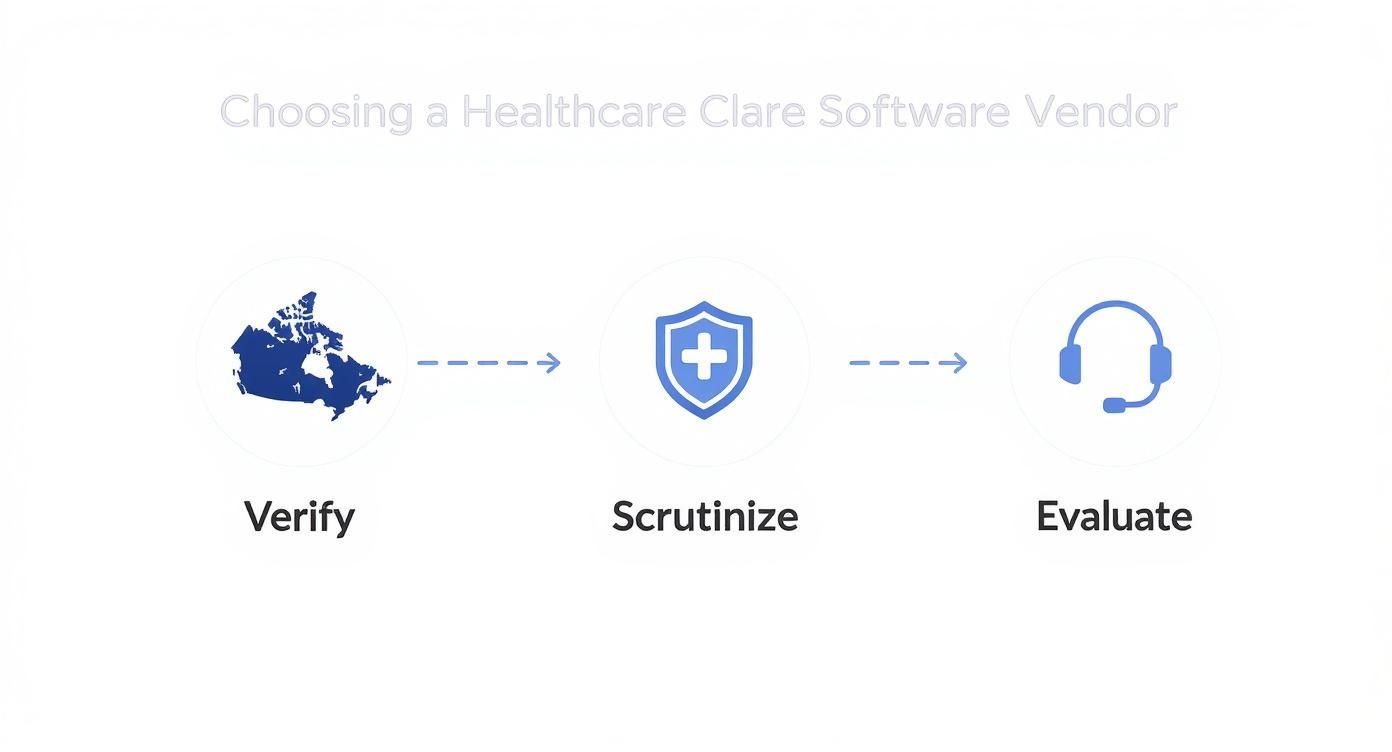
As you can see, vendor selection is its own structured process, designed to make sure you partner with someone who can actually handle a secure and compliant migration.
Onboarding Your Team for Success
Great technology is only half the battle; your people are the other half. The single most important factor for a smooth transition is making sure your staff feels prepared and confident using the new software. Good training isn't just a "nice-to-have"; it's absolutely central to getting the full value from your investment.
A top-notch vendor will provide a training program that's customised for the different roles in your clinic:
-
Administrative Staff Training: This should focus on their world – scheduling, patient check-in, and billing workflows.
-
Clinical Staff Training: Here, the emphasis is on charting, sending e-prescriptions, managing lab integrations, and using secure messaging tools.
-
"Super User" Training: It's a great idea to pick one or two tech-savvy team members for more advanced training. They can become your go-to experts for day-to-day questions from colleagues.
When you invest time in proper training, you turn anxiety into genuine excitement. It ensures the new system is adopted with enthusiasm, not resistance. This careful planning guarantees that from day one, your new cloud software is a tool that truly helps your team and improves patient care.
Answering Your Key Questions
Deciding to bring new technology into your practice always stirs up a lot of questions. Moving sensitive patient data to the cloud is a huge step, and you absolutely need clear, straightforward answers before you commit to anything. This section is all about tackling the most common and most critical questions we hear from Canadian healthcare providers when they're thinking about a cloud-based platform.
We’re going to cut through the jargon and give you practical answers to your biggest concerns, from the security of your patient data to how the software actually works day-to-day. The goal here is to give you the confidence to make the right call for your clinic's future.
Is My Patient Data Really Secure in the Cloud in Canada?
This is almost always the first question, and for good reason. The short answer is a resounding yes, as long as you choose the right partner. Reputable cloud-based healthcare software in Canada comes with security measures that are often miles ahead of what a private practice could manage or afford on its own.
I like to use the bank vault analogy. You could keep your valuables in a safe at home, and that offers some protection. Or, you could put them in a bank vault with 24/7 surveillance, reinforced walls, and a dedicated security team. A compliant cloud provider is the bank vault for your data.
They have entire cybersecurity teams working around the clock, actively monitoring for threats. They also use advanced security protocols like end-to-end encryption (which scrambles data so it's unreadable) and multi-factor authentication to make absolutely sure only authorised people get in.
The most critical piece of the puzzle, though, is a contractual guarantee that your data will be stored exclusively on Canadian servers. This is non-negotiable. It ensures your data stays protected under Canadian privacy laws like PIPEDA and provincial acts like PHIPA, turning the cloud into a fortress for your patient information, not just a digital filing cabinet.
What’s the Difference Between EHR and EMR Software?
This is a really common point of confusion, but the distinction is pretty simple and has a big impact on how you coordinate patient care. Think of the two terms as representing different parts of a patient's health story.
It breaks down like this:
-
An EMR (Electronic Medical Record) is the digital version of a patient's chart from a single clinic. It's one chapter of their health story, written by your practice. It’s great for your internal records, but it wasn't built to be shared easily.
-
An EHR (Electronic Health Record) is the whole book. It’s a complete, holistic record designed to be securely shared among authorised providers across the healthcare system – your clinic, specialists, hospitals, and labs.
An EHR gives everyone involved a complete picture of a patient's health journey. For the kind of modern, collaborative care we're all aiming for, where information needs to move smoothly between providers, an EHR is by far the more powerful and future-proof choice. A great Canadian example is AlayaCare, which built a cloud platform that’s all about improving healthcare through better data management.
How Does Cloud Software Connect with Labs and Pharmacies?
This is where modern cloud platforms really shine. They aren’t designed to operate in a bubble. Instead, they use secure, standardised protocols – like Health Level Seven (HL7) and Application Programming Interfaces (APIs) – to "talk" to other healthcare systems. You can think of these as universal translators for health data.
In your day-to-day workflow, this integration makes a massive difference.
-
For Labs: When a patient's lab results are ready, they can be sent electronically and pop up automatically in their chart within your software. No more staff members chasing down results with phone calls or waiting by the fax machine.
-
For Pharmacies: This is what enables secure e-prescribing. You can send a prescription directly from the patient's chart to their pharmacy of choice. The process is faster, it cuts down on the risk of errors from hard-to-read handwriting, and it leaves a clear digital trail.
This kind of automation dramatically reduces administrative busywork, minimises the chance for mistakes, and just speeds up the whole care cycle for your patients.
What Are the Typical Costs of Cloud Healthcare Software?
This is obviously a key question for any practice manager or clinic owner. Unlike the massive upfront cost of buying and maintaining on-premise servers and software licences, most cloud solutions run on a subscription model. You’ll often hear it called Software-as-a-Service (SaaS).
You typically pay a predictable per-provider, per-month fee. The big advantage here is that it turns what would have been a huge capital expense (CapEx) into a much more manageable operating expense (OpEx). That makes budgeting a whole lot simpler.
When you're looking at costs, make sure you ask for the full picture to avoid any surprises down the road. On top of the monthly subscription, you should ask about other potential fees, like:
-
A one-time setup and data migration fee.
-
Charges for initial or advanced training for your team.
-
Costs for premium-tier customer support.
A good, transparent vendor will lay all of this out for you from the start. That way, you can build a realistic financial plan that actually fits your clinic’s budget and long-term goals.
Figuring out the world of healthcare technology can feel overwhelming, but you don't have to go it alone. The expert team at Cleffex Digital Ltd specialises in developing secure, compliant, and user-friendly software solutions designed specifically for the Canadian healthcare landscape. We can help you build a platform that streamlines your operations and lets you focus on what really matters – enhancing patient care.
Ready to build the future of your practice? Contact Cleffex today to discuss your project.


